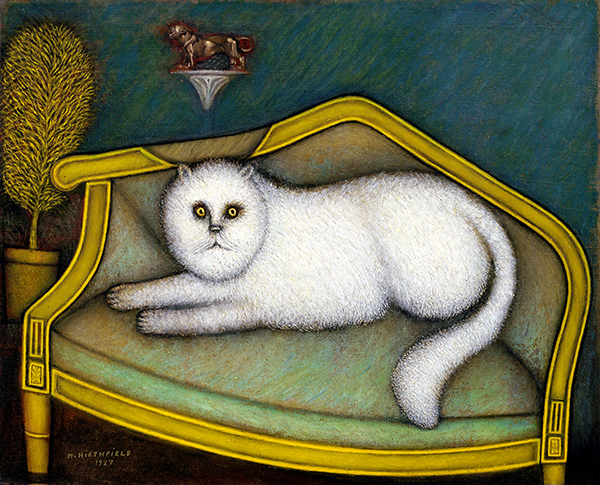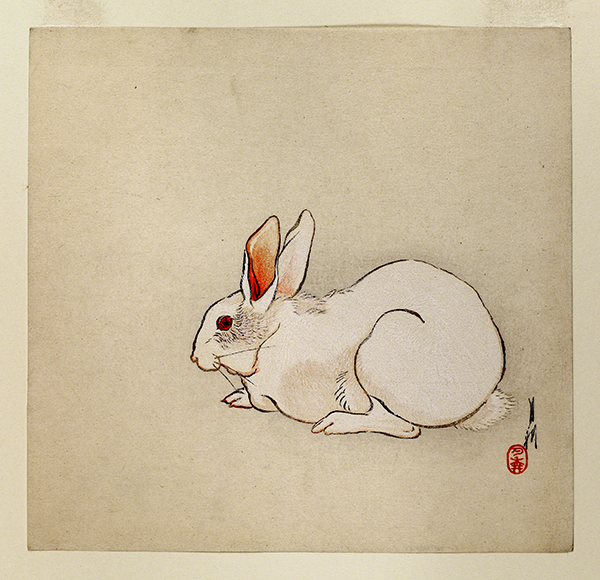Kittens and Bunnies
It’s been a crazy year with this awful pandemic going on, and an equally crazy last two weeks with this nutty election. I think we all need some kittens and bunnies to recoup our mental health. Look at these two adorable works and everything will be better!
 |
| Morris Hirshfield (1872–1946, U.S., born Poland), Angora Cat, 1937/1939. Oil on canvas, 22" x 27 3/16" (56.1 x 69.1 cm). The Museum of Modern Art, New York. © 2020 Estate of Morris Hirshfield / Licensed by VAGA at Artists Rights Society (ARS), New York. (MOMA-P1707hfvg) |
Like most self-taught artists, Morris Hirshfield's works are typified by an emphasis on details of texture and display little awareness of nuances of light and dark, logical space, or correct proportions and scale. Although he was a master at symmetrically balanced compositions, the majority of his works are asymmetrically balanced, often by the addition of highly detailed borders or meticulously detailed plants, such as in Angora Cat. He could display a sophisticated sense of color, although his forms are usually a combination of flat and modeled. Animals played a large role in many of Hirshfield's paintings, either as the featured subject or playing a major subsidiary role.
Hirshfield displayed artistic talent as a child in Poland when he created a sculpture for his local synagogue. Although he continued to create impressive religious sculptures during his youth, he did not seriously pursue art as a vocation until the last ten years of his life. He immigrated to the U.S. at 18 with his brother and became involved in the clothing industry in Brooklyn, ultimately with a successful business manufacturing slippers. Ill health forced his retirement in 1935, and he took up painting seriously in 1937.
Totally self-taught, Hirshfield initially expressed disappointment in the results of his painting efforts, admitting that what he pictured in his mind did not come out as he hoped on canvas. He was acquainted with future gallery owner, shoe store king, and art collector Sidney Janis (1896–1989) through his slipper business, and it was Janis’s position on the board of the new Museum of Modern Art, New York, that got two of Hirshfield’s paintings exhibited there in the 1939 exhibition Unknown Americans.
Janis appreciated Hirshfield’s work for its spiritual similarity to Surrealism, a movement in which Janis was greatly interested. Through the interest of another wealthy collector of contemporary art, Peggy Guggenheim (1898–1979), Hirshfield was given a one person show at the Museum of Modern Art in 1943. Critics dubbed his work “folk art.”
 |
| Ogata Gekkō (1859–1920, Japan), White Rabbit, ca. 1890–1910. Color woodblock print on paper, 9 1/2" x 9 7/8" (24.1 x 25.1 cm). © 2020 Brooklyn Museum. (BMA-2378) |
The asymmetrical composition of this print is one of the attributes of ukiyo-e art that greatly influenced the work of late-1800s European modernists. Contour lines are extremely subdued in Ogata Gekkō's work, which is especially evident in the placement of the rabbit in this composition. This image may have been intended for surimono, a type of holiday card exchanged privately on New Year's and other occasions, always containing a poem. The rabbit would be an appropriate New Year's symbol, representing cleverness and devotion, both good traits to tout at the beginning of a new year.
While the heyday of the ukiyo-e style featuring multiple woodblock color prints had past by about the 1850s, the genre persisted into the 1900s. Gekkō was somewhat of an anomaly compared to past artists in the woodcut print field. He does not appear to have done the traditional apprenticeship to a master artist, and apparently was self-taught.
Gekkō's early career was as an illustrator and designer of advertisements. Influenced by traditional Chinese painting, his early career as an artist was as a painter, illustrator, and decorator of lacquer work. In the 1880s, he became interested in printmaking in the ukiyo-e style. While the historical ukiyo-e style produced subjects of beauties, actors, and landscapes, Gekkō preferred genre subjects, landscapes, and particularly animals and plants. "Birds and Flowers" (kacho-e) was a traditional subject of series of prints in traditional ukiyo-e printmaking.
Since he eschewed the strict linearity of earlier ukiyo-e in favor of a style that imitated brush work, Gekkō’s style was unique in woodblock printing. Like Chinese studies of nature, Gekkō focused solely on the study to the negation of background.
Gekkō was the first Japanese artist to be internationally acclaimed. He displayed his prints at the Chicago Columbian Exposition in 1893, the Paris world exposition in 1900, the Louisiana Purchase Exposition in Saint Louis in 1904, and the International Exposition in London in 1910. At the Louisiana Purchase Exposition, he received a medal for one of his print series.
Born Nakagami Shōnosuke, Gekkō took the name Ogata in 1884 in honor of the famous painter Ogata Kōrin (1658–1716). The name Gekkō means “moonlight.” Gekko believed that he was upholding the tradition of ukiyo-e.
Correlations to Davis programs: Explorations in Art 1E Grade 3: 5.25; Explorations in Art 1E Grade 4: 4.20; Explorations in Art 1E Grade 5: 4.21, studio 4.21-22; Explorations in Art 1E Grade 6: studio 2.9-10, studio 2.11-12; Explorations in Art 2E Grade 3: 5.1, 5.2; Explorations in Art 2E Grade 5: 4.4, 4.5, 4.6; Explorations in Art 2E Grade 6: 2.9


Comments